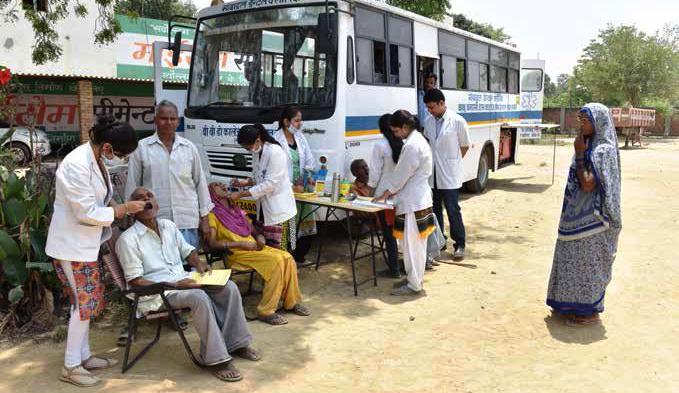“Women are not dying because of diseases we cannot treat… They are dying because societies have yet to make the decision that their lives are worth saving.”
– Mahmoud Fathalla,
Chair of the WHO Advisory Committee on Health Research
Inclusive growth is now perhaps the strongest buzzword in development discourse. We have all been talking about growth without understanding that development interventions will not be effectual if they don’t benefit all sections of society. The illusion of trickle-down and ripple-effects of growth had kept us on the wrong track for quite some time. An important new learning is that health (or healthcare) is a key component of inclusive growth. It is an important piece in the development ecosystem. In independent India too, inclusive health was identified as a hallmark of the country’s policy architecture.
This year marks the 40th anniversary of an important signpost in the world’s history of healthcare. At a conference on October 25–26 in Almaty, Kazakhstan, the Alma Ata Declaration was adopted by the World Health Organization (WHO) with a pledge to focus on primary healthcare. The vision was to bring healthcare closer to people, by creating a network of rural dispensaries.
Since then, there have been continuous efforts for establishing strong primary care systems in local communities in a bid to achieve universal healthcare (UHC). The results have not been uniform on account of several policy deficiencies. The pursuit of ‘vertical’ programmes (targeting a single disease) has resulted in health services functioning in silos in an uncoordinated manner and being unable to respond to people’s real health needs, which are complex and can be addressed only by a range of healthcare channels.
India is home to several internationally acclaimed home-grown models of community healthcare. The earliest innovators were two doctor couples in Maharashtra: Abhay Bang and his wife Rani in Gadchiroli, and doctors Raj and Mabelle Arole in Jamkhed separated by a distance of 664 kms. The Bangs set up the charity SEARCH (Society for Education, Action and Research in Community Health) in 1985, whereas the Aroles founded the Comprehensive Rural Health Project, (CRHP) in 1970.
CRHP is a comprehensive approach to primary health care at the community level, mobilising communities to use simple tools, adapted to the local context, to address priority health needs. In 1972, the World Health Organisation officially recognised CRHP’s pioneering work in villages, also known in the global health community as the Jamkhed model. The innovation of this approach lies in involving the communities themselves, especially those who are poor and marginalised, in designing their health and development programmes. Through their ‘Shodh Gram’ hospital, the Bangs operate their home-based new-born care model. This model does not depend upon doctors, nurses, hospitals or expensive equipment. It empowers women to use simple medical knowledge and skills to save their new-borns.
A relatively recent innovation is the Arogya Sakhi model promoted by Prema Gopalan in western Maharashtra who established the acclaimed non-profit Swayam Shikshan Prayog (SSP), which selects and trains women who are landless, but have basic education. These Arogya Sakhis are equipped with health devices, such as glucometers, blood pressure machines and a mobile tablet. They visit rural women door-to-door to conduct basic medical tests.
Corporate India has been quite alive to traditional community models and has been replicating it through either their CSR or social business programmes. Through ‘Aarogya’, the health initiative under its CSR programme, Tata Motors operates mobile health clinics for remote tribal community outreach, offering last-mile aid. Arogya Parivar, another successful community-centric health model, is a sustainable social business initiative by Swiss drug maker Novartis, and not a Corporate Social Responsibility project. Social business is a for-profit model whereas CSR is not-for-profit. The awareness generated in remote villages by the Aarogya Parivar animators is followed-up with a nearby doctor or by connecting via the internet to a doctor at a larger hospital who helps with diagnosis.
Given the magnitude of the healthcare challenge in India, philanthropy is not enough. We also need scalable business models that take into account the needs of society. At present about 24% of the total spend on CSR is focused on healthcare. However, much of the spending tends to be focused on health camps and building hospitals or donating to hospitals for upkeep of facilities. Health camps tend to have a short-term orientation and are number-driven.
There is a need to focus on primary care rather than tertiary care. The local youth could be trained to advise residents on simple treatments. Community health workers, supported under CSR, could help with basic diagnostics like blood pressure, pulse, and sugar testing. India is now a far better placed to make inclusive health a reality. An enormous social capital has been built up over the years which can be leveraged to support innovations in healthcare for development of new and affordable drugs, therapies or medical devices.
 Moin Qazi is an author, researcher and development professional who has spent four decades in the development sector. He worked for three decades with State Bank of India as a grassroots field officer, program manager, CSR head and policy maker. He has written for publications around the globe including Hindu Business Line, The Asian Age, The Statesman, The Indian Economist, Deccan Chronicle and The Pioneer. He has been actively associated with empowerment of women and education of girl children, child labour and affordable housing programmes for the rural poor.
Moin Qazi is an author, researcher and development professional who has spent four decades in the development sector. He worked for three decades with State Bank of India as a grassroots field officer, program manager, CSR head and policy maker. He has written for publications around the globe including Hindu Business Line, The Asian Age, The Statesman, The Indian Economist, Deccan Chronicle and The Pioneer. He has been actively associated with empowerment of women and education of girl children, child labour and affordable housing programmes for the rural poor.
Views of the author are personal and do not necessarily represent the website’s views.
Thank you for reading the column until the very end. We appreciate the time you have given us. In addition, your thoughts and inputs will genuinely make a difference to us. Please do drop in a line and help us do better.
Regards,
The CSR Journal Team


